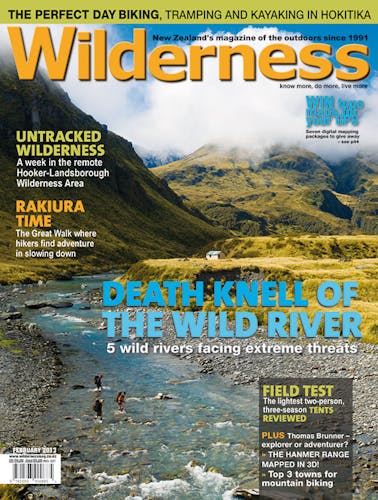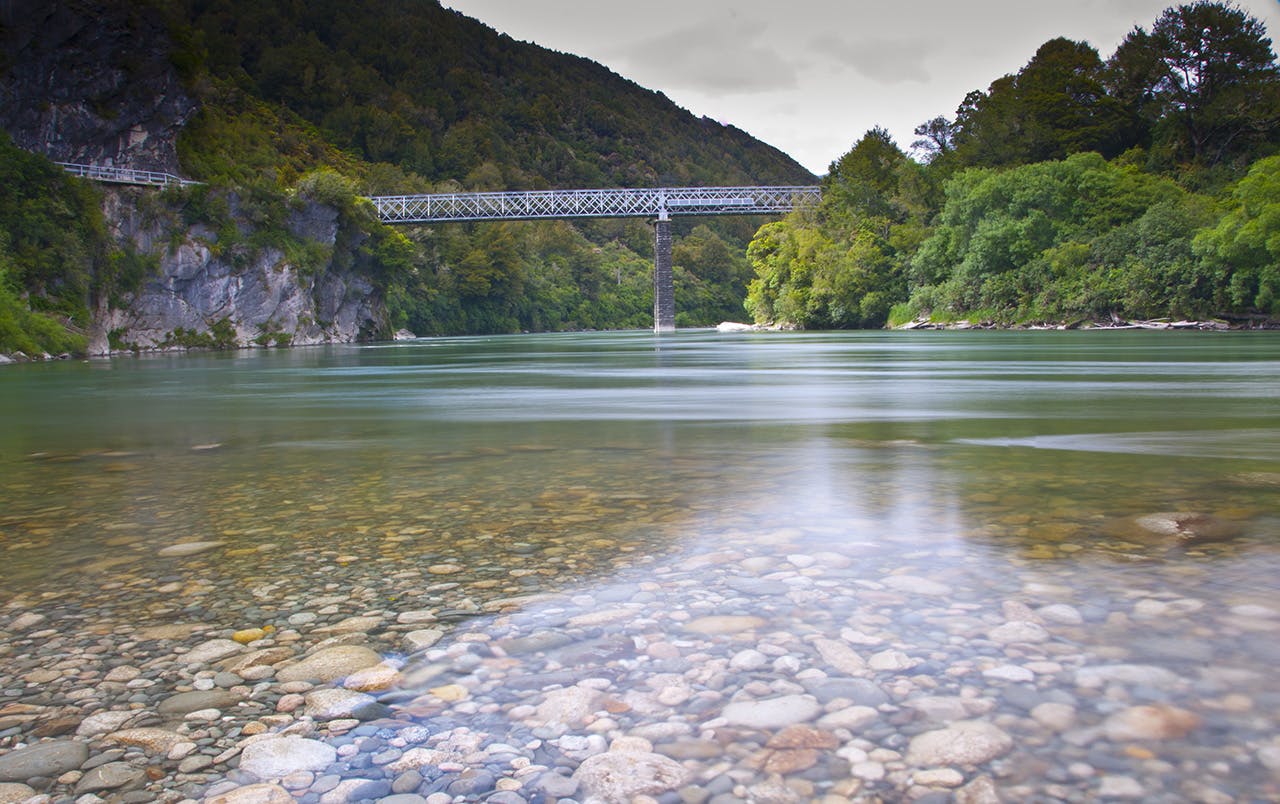Is New Zealand really 100% Pure? Clean and Green? Many argue its not and point to the state of the country’s rivers as proof. Wilderness investigates five rivers that are facing threats from pollution, hydro or irrigation
1. The Tarawera River, Bay of Plenty
Threat: Pollution
“How about fresh salad?” Bruce Webber asks as he turns into a seldom-used forestry road without a café in sight.
Pine trees shade the road and I catch a glimpse of the Tarawera River as Webber not-so-carefully dodges one pot hole after another.
A few metres on, he pulls over to the side of the road.
“It’s kind of peppery like rocket and is absolutely delicious,” he says, marching down a thin track. “Local Maori have their own secret spots to collect it and they get pissed off if someone else finds it.”
I’d never tried watercress before, but after the first cautious mouthful I was munching it by the bunch.
We stood on the bank of the fast flowing Tarawera River eating and talking about the river’s past and future. Webber says it’s one of New Zealand’s best kept recreational secrets.
He runs a rafting and kayak guiding company and works for Kawerau Blue Light Ventures, a charity organisation run by the New Zealand Police to help young people. He takes troubled Kawerau kids down the river and he can’t get enough of it.
“Usually at the start of the day they can’t be bothered, but by the end of the day they’re over the moon,” Webber says. “I love seeing the buzz it gives them.”
Webber would like the locals to take advantage of the river more, but despite his best efforts not one local kid has gone on to become a dedicated paddler.
The problem, he says, is few families can afford to pay for the pursuit. Kawerau has been called the DPB Capital of New Zealand. There are 1324 working-age beneficiaries in the town which has a population of around 6940.
And things aren’t getting any better.
In January, Norske Skog, which operates Tasman Mill in Kawerau, announced 110 job losses from shuttering one if its two paper machines.
Not everyone, however, is lamenting the mill’s decline.
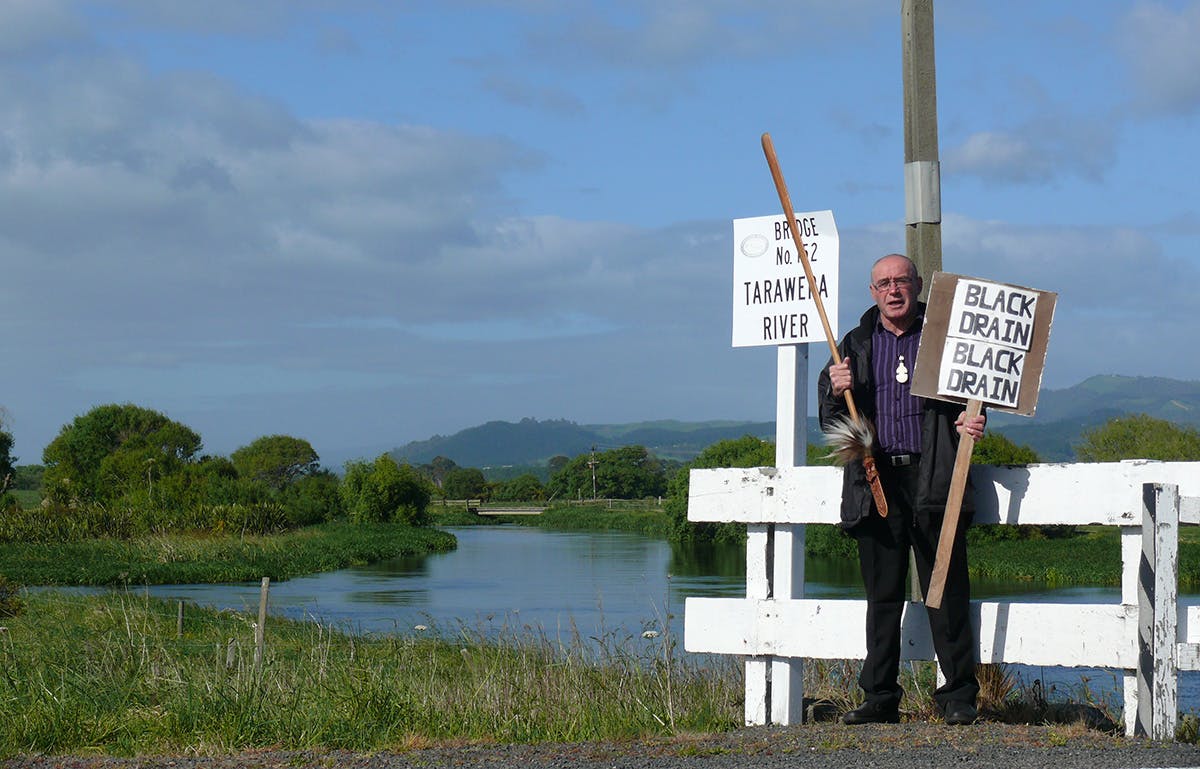
Ngati Rangitihi iwi member Tipene Marr has long protested the polluting effects of the Kawerau mills. Photo: Josh Gale
Ngati Rangitihi iwi member and Bay of Plenty Regional Councillor Tipene Marr would like nothing more than the mill to shut down tomorrow.
Marr has been one of the mill’s most vocal critics because since it began operating in 1954 its various owners have been permitted by law to discharge industrial wastewater into the Tarawera River.
The mill takes water from the river, adds chlorine and other chemicals to bleach the pulp, then treats the water biologically in a pond before discharging it back into the river.
What was once a pristine river from source to coast, famous for its whitebait and eel, turned black from the point where the mill discharged its effluent. In 2010, Parliamentary Commissioner for the Environment Jan Wright presented her list of New Zealand’s filthiest rivers to Parliament and Tarawera came in at number two, behind Taranaki’s Waingongoro River.
After my leafy lunch with Webber, I smelt the mill’s infamous stench as I drove past it on my way to meeting Marr in the coastal settlement of Matata.
For years, Marr daily protested the mill’s polluting of the river by standing on Thornton Bridge, his taiha in hand.
“The stuff that comes out of the mill falls on workers’ cars and takes the paint off,” Marr says. “That’s what’s been going into the river.”
Marr says local iwi would have never given the Government the land for the mill in 1949 if its leaders knew how polluted the river would become.
The pollution has meant the mauri – the river’s life force – has been diminished and with it, Marr says, the iwi’s mana.
“We have been deprived of a food source,” he says.” They used to pull up whitebait nets before it was polluted and fill whole kerosene tins in one hit.
“In today’s world we’ve got to go to Pak ’n Save like everybody else.
“We can’t take tunna (eel) or watercress from Tarawera below the mill and feed it to our guests, no way; we’re likely to poison them.
“The Government owned that place 51 per cent until the 1970s so it can’t run away from this – the word ‘compensation’ comes to mind.”
Marr and other protestors dubbed the river The Black Drain because of the mill’s discharge and gradually the name stuck.
Marr is furious the mill was granted resource consent in 2009 to continue polluting the river for another 25 years.
There are two mills in Kawerau, a kraft pulp mill operated by Carter Holt Harvey Paper (CHH) and the Norske Skog (NS) mill. They jointly operate the waste and water services.
In 1954, the Government passed an Act of Parliament, the Tasman Pulp and Paper Company Enabling Act, specifically to allow the Kawerau mills to pollute the river because their contribution to New Zealand’s economy was deemed too significant to obstruct.
Then, in 1994, with the introduction of the Resource Management Act (RMA), mill owners applied for resource consent and were granted it in 2003 for a term of 10 years. These consents were due to expire in December 2012, but the owners applied for new consents in 2009 which were granted for a term of 25 years.
While the RMA prohibits any discharges to waterways likely to cause a conspicuous change in water colour or have any significant adverse effects on aquatic life, it allows for discharges where and when ‘exceptional circumstances’ justify it.
In the case of the Kawerau mills, exceptional circumstances include the economic and social benefits they bring to the Bay of Plenty and New Zealand.
Because the clause for exceptional circumstances has not been defined or time-constrained, it allows for ongoing pollution.
It’s not just the mills that have used the clause to pollute. Gisborne District Council, for example, used the clause for 30 years to justify discharging the town’s sewerage into the ocean.
However, Green MP for Coromandel Catherine Delahunty is trying to put a stop to this. She says exceptional circumstances shouldn’t apply to the mills as it’s really a case of business exploiting a convenient loophole in the RMA.
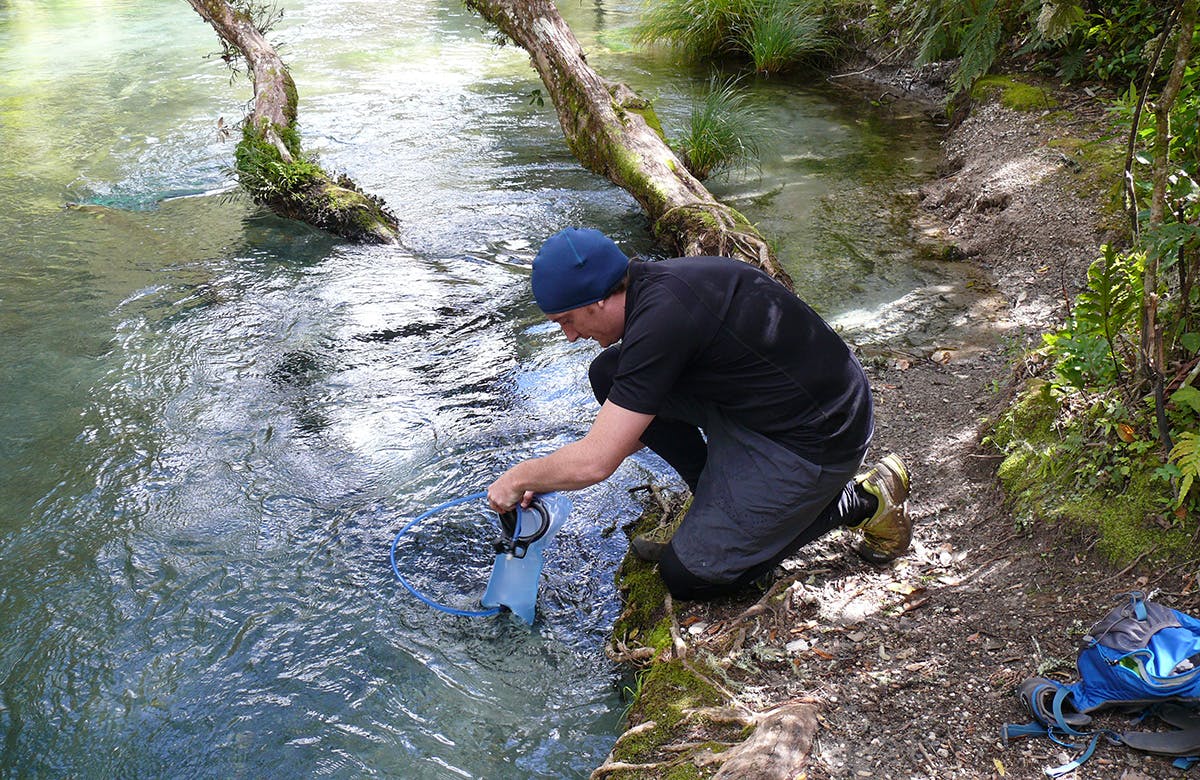
The author collects water from an area above the mills, where it is still safe to drink. Photo: Josh Gale
Delahunty has sponsored an Amendment Bill to close this loophole by setting a five year limit on exceptional circumstances.
The Resource Management (Restricted Duration of Certain Discharge and Coastal Permits) Amendment Bill has passed its first reading in Parliament despite opposition from the National and Act parties.
“The river has been subjected to thousands of tonnes of pulp mill waste being dumped into it since 1955 and all kinds of legal excuses used to justify this ongoing pollution,” Delahunty says. “One of the reasons I wanted to be an MP was to stand up for this river and the many people over many years that have fought for its clean up.
“The whole issue around chemicals, particularly chlorinated chemicals, is a real worry because [people] underestimate how a millionth of a millionth of a gram can actually have a health effect and can cause cancer.”
Delahunty and Marr say there is anecdotal evidence that the communities based around the mills have experienced a high cancer rate, but it’s difficult to prove it’s a result of wastewater from the mill.
New Zealand lags behind other countries, most notably those in the European Union, in recognising the danger to human health that chemicals pose, Delahunty says.
She calls it ‘chemical denial’ and it’s not just about ignoring the danger of chemicals generally, but the more complex issue of how chemicals work together.
If one millionth of a millionth of a gram of chlorinated chemicals can potentially cause cancer, Delahunty worries what millions of grams in the Tarawera River are doing.
Kawerau Mayor Malcolm Campbell says “prove it”.
“They’re saying there are a whole lot of nasties in the river, but we’re saying show us where that threat is,” Campbell says. “People say they discharge lots of heavy metals and chemicals, but a lot of that comes from the geothermal [operation further upstream], too.
“You have to be careful how you approach it.”
Studies of the river commissioned by the mills have concluded the only remaining pollution issue is the discolouration.
Kawerau District Council submitted against Delahunty’s Amendment Bill, says Campbell, because without the clause for exceptional circumstances it would force the mills to shut down.
For the mills, the cost of upgrading their technology to oxygen-based bleaching would be too great, making newsprint from China and India cheaper, effectively putting them out of business.
“Our biggest rate payers are Norske Skog and Carter Holt Harvey and it would come at a huge cost if they shut down,” says Campbell. “You would also shut down Kawerau, Whakatane and the Port of Tauranga would be almost crippled.”
According to government website Careers New Zealand, in 2007 the wood and paper product manufacturing industry in the Bay of Plenty employed 4759 people and more than 60 per cent of the products made were shipped to Asia through the Port of Tauranga. A lot of people can put bread on the table thanks to the mills.
Marr and Delahunty, however, say the mills have had long enough to upgrade their technology and argue they are a classic case of corporations, one owned by Graham Hart, New Zealand’s wealthiest man, externalising their costs and making the community pay for their impacts.
They say the studies commissioned by NS and CHH which showed discolouration to be the only issue remaining were biased and that iwi and community groups lack the funds to commission their own studies to prove the discharged chemicals are causing damage.
Delahunty says scientific consultancies are financially dependent on contracts with corporations like the Kawerau mills and are unlikely to bite the hand that feeds them by turning in negative reports.
But Environment Bay of Plenty (EBOP) senior environmental scientist Stephen Parks says any scientist who skews the research in favour of their client will have a short career.
“You can’t bend the science because the reports are out there in the public domain anyway,” Parks says. “You can send them to anyone who is an expert in the area and ask them to peer review it and they will give you their opinions on any shortcomings in the data.
“If someone tried it they’d open themselves up to suddenly ending their careers and having no future in science.”
But Massey University freshwater scientist Dr Mike Joy says bias is a “huge issue” in New Zealand’s scientific consultancies. Joy is the director of Massey University’s Centre for Freshwater Ecosystem Management and Modelling and made headlines late last year for comments published by the New York Times that criticised the New Zealand’s 100% Pure, clean, green branding.
“There is nobody giving scientific consultancies money to write reports saying the rivers are bad, but there is heaps of money if you’re willing to write reports saying there’s not an impact,” Joy says. “Of course that causes a bias.
“There are so many examples of really crap science where they’ve just twisted everything to make it sound positive.”
Joy says he’s seen countless examples of scientific reports prepared by consultancies that favour the interests of their clients.
“It used to be little consultancies that did this crap science, but now unfortunately it’s the big ones,” he says.
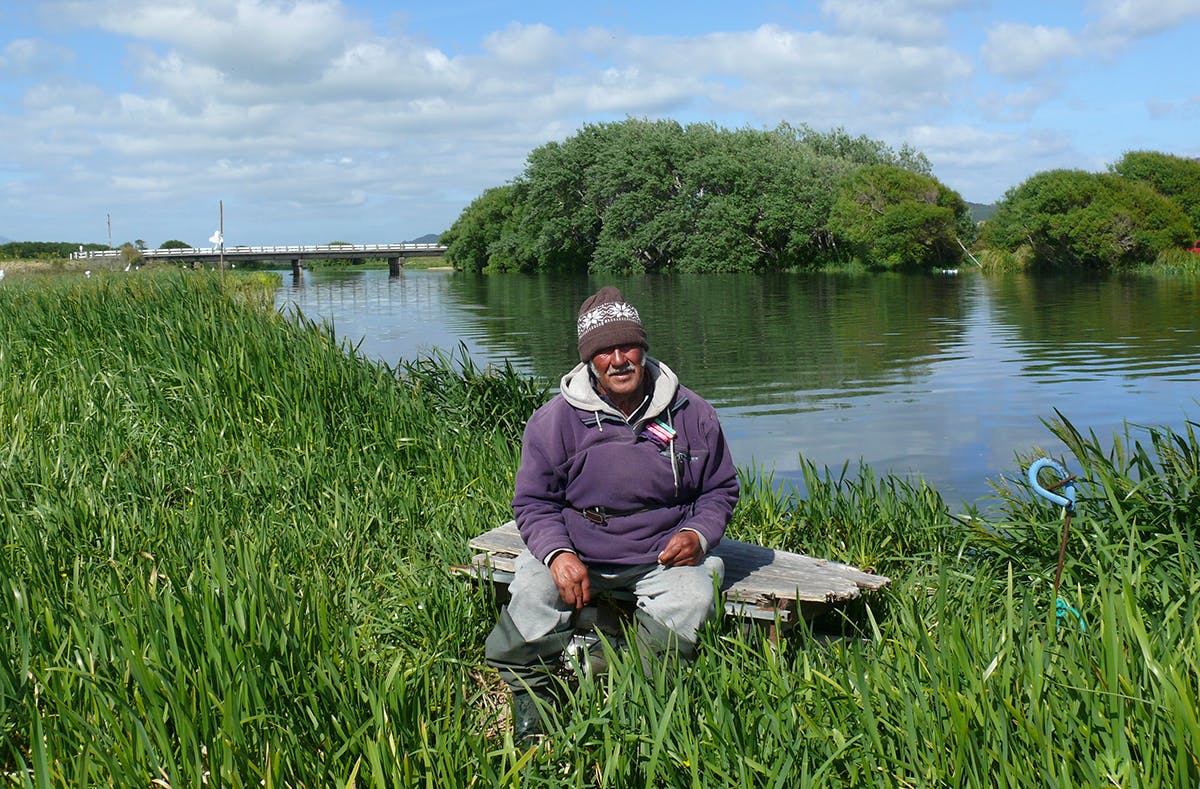
Whitebaiter Michael Kerrison wants the mills to stop polluting the river. Photo: Josh Gale
He believes the system needs to change to one where an independent environmental protection agency funded by government conducts the research, otherwise science will lose credibility in this country.
Joy points to recent studies showing 68 per cent of New Zealand’s native fish are threatened and, if agricultural intensification continues, his modelling suggests they’ll be gone by 2050. He says 90 per cent of New Zealand’s lowland pastoral rivers are now unswimmable, 68 per cent of the country’s ecosystems are threatened, 43 per cent of its lakes are polluted, 90 per cent of wetlands have been destroyed and between 18,000 and 34,000 people contract waterborne diseases in New Zealand every year. Now more than ever, science must be dependable and robust he says.
He likens the current scientific debate around the state of freshwater in New Zealand to the misleading science touted by the tobacco industry.
“One of the things [the tobacco industry] got really good at was suggesting there wasn’t a problem by putting out stories to question the science. There is no doubt that this is happening in New Zealand with the freshwater issue as well.
“Some of the industry players are intentionally muddying the waters.”
After meeting Marr in Matata, I drive over Thornton Bridge at the mouth of the Tarawera River where whitebaiters are fishing.
I drive to the river’s edge and ask them what their views of the mills are. One tells me the river is getting worse and that whitebait numbers are decreasing.
On the other side of the river is 67-year-old Michael Kerrison. He’s been whitebaiting on the Tarawera River for more than 60 years and knows the river better than most.
Kerrison has replanted large tracts of the river with weeds for the whitebait to lay their eggs on. He remembers swimming at the mouth of the Tarawera as a boy.
“That’s how clean it was,” he says. “The water was pure, but now I wouldn’t take my grandchildren in there.”
Kerrison says the river is getting cleaner and will recover if the mills stop discharging their waste into the water. The number of whitebait is slowly increasing, but he says that’s due to his weed planting.
After living off the river for 60 years, Kerrison has learned to detect the effects of the mills’ discharge. Sometimes he finds green whitebait which he thinks is a result of them spending a night in the floodgates and being exposed to the chemicals in the river.
He regularly finds dead eels and water fowl on the beach and also sees herring floating on the water. “They probably died from the chemicals,” he surmises. “The watercress down here is also really bitter.”
He claims the eels upstream of the mills are cleaner and taste different to the ones downstream.
Bruce Webber holds conflicting views on the mills. He would prefer it if they stopped discharging into the river, but says it’s not as simple as that. He says Kawerau was founded on the mill which has created a huge number of jobs and the social benefits of this must be considered alongside the environmental benefits of stopping the discharges. But he also supports Delahunty’s bill to limit how long the mills can continue to pollute the river.
“If they’re using a loophole, that should be shut straight away and they’ve just got to suck it up and deal with it,” he says. “They’re taking a whole lot of water out of the river and putting it back in black. That’s not kosher.”
2. Hurunui River, Canterbury
Threat: Damming
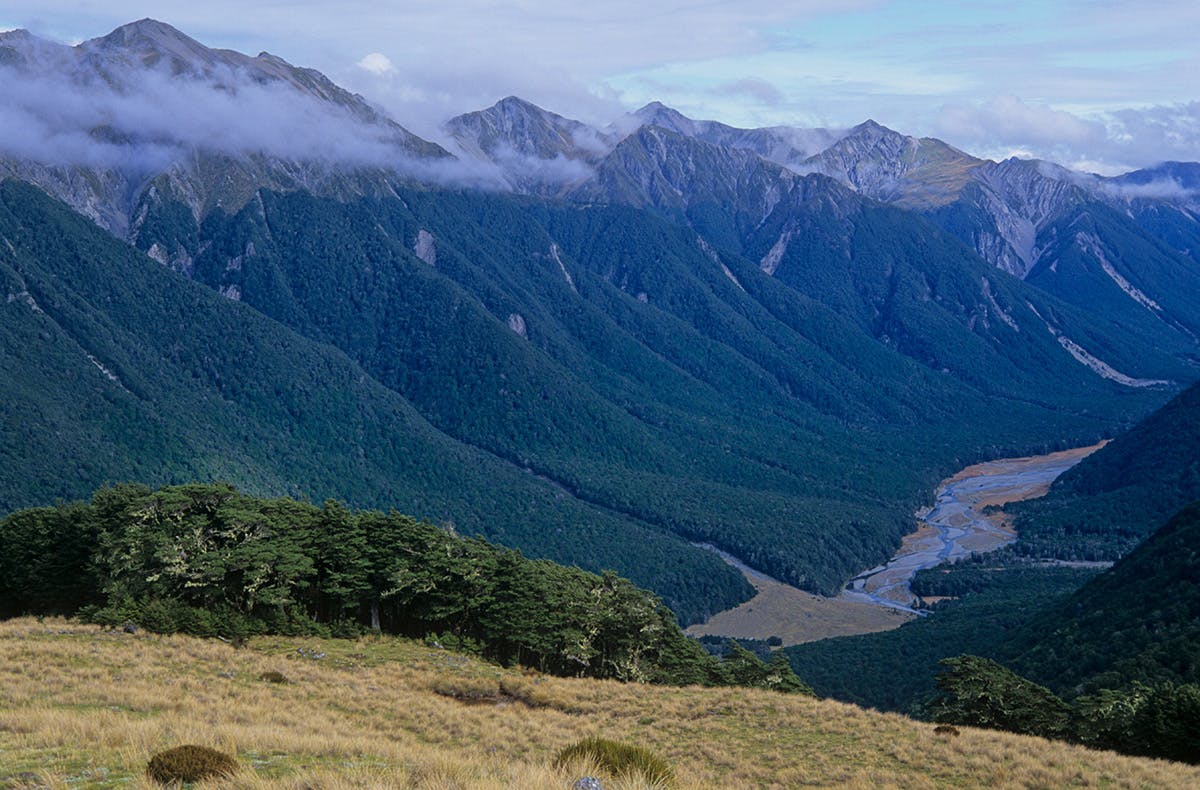
The Hurunui River South Branch is threatened by a 75m-high dam. Photo: Shaun Barnett/Black Robin Photography
Starting at the eastern side of the Southern Alps, the Hurunui is the fourth largest river in Canterbury and one of New Zealand’s most important white water training runs.
“I think there would be very few kayakers in the South Island that hasn’t at spent some time on the Hurunui learning,” says Matt Bennett, president of White Water New Zealand. “It is one of the most used beginner kayaking and teaching runs in the country.”
In 2009, the river was threatened by a proposal put forward by the The Hurunui Water Project (HWP), consisting of 200 landowners in the area, including Main Power and Ngai Tahu Property, to build a 75m high dam on the Hurunui South Branch, upriver from North Esk River, to create water storage for irrigation and for power generation. This would create a 7km long lake, resulting in 525ha of the river branch being inundated. The proposal also included building a weir on the north branch on the exit to Lake Sumner.
Opponents said if the proposal went ahead it would effectively privatise the river, allowing HWP to control flows for its own profit. Due to strong opposition, HWP looked at other options and eventually agreed to consider an alternative proposal suggested by kayakers to instead dam the Waitohi River, a tributary of the Hurunui, and extract water from the Hurunui below the best white water. This proposal is more expensive and has some shareholders worried, leading Bennett to think HWP might revert to the original proposal.
3. Waitaha River, West Coast
Threat: Power generation
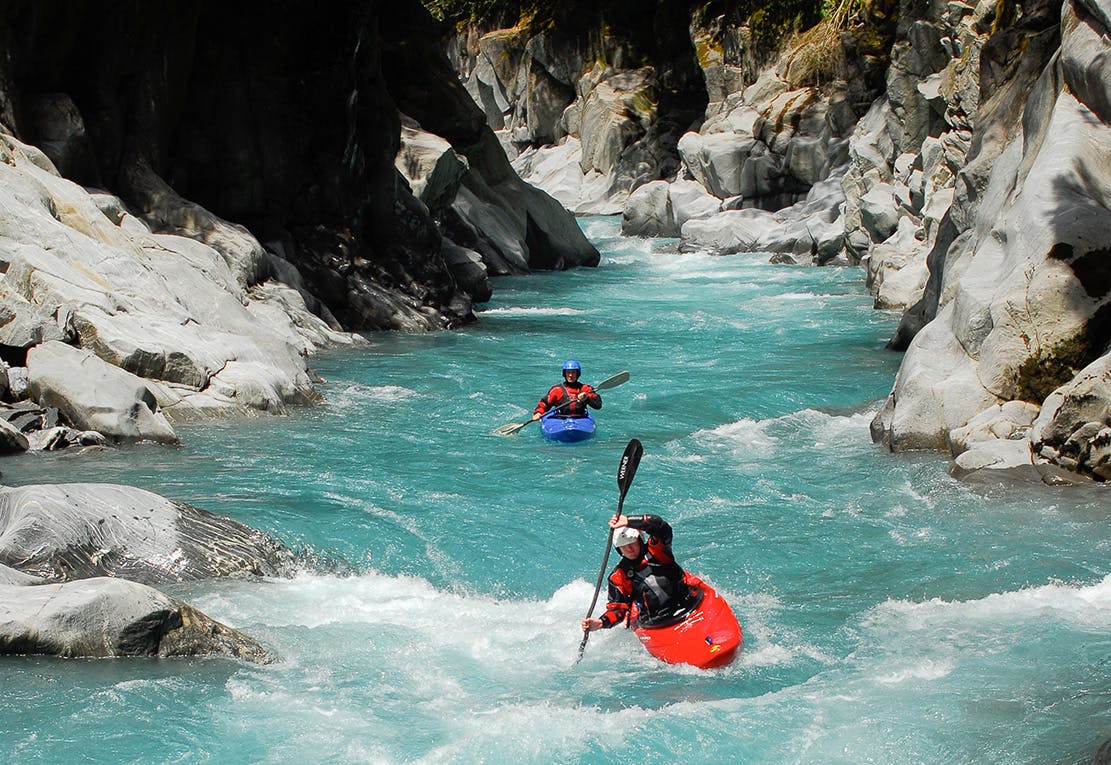
The Morgan Gorge is an endangered natural feature of the Waitaha River. Photo: Zak Shaw Photography
The West Coast’s Waitaha River is a wild and untouched, pristine river with luminous blue glacial water is one the country’s top grade five rivers.
Tai Poutini Polytech outdoor recreation tutor Keith Reilly is one of only 10 people to have ever kayaked the river’s 1km Morgan Gorge, famous for its 200m sculpted rock walls and grade five rapids. Reilly is opposed to a proposal from West Power to construct a tunnel running parallel to the gorge to pipe water to a powerhouse located on the flats below.
“On a world scale, pristine, free flowing rivers like the Waitaha are a rarity and we have to preserve them and recognise they’re not a commodity,” Reilly says. “Very few people will ever kayak through Morgan Gorge and very few will ever see more than more than 0.5 per cent of our national parks, nor will they go to Antarctica. But we feel compelled to protect these places because they’re wild and untouched and we want to keep them that way.”
White water veteran and owner of the New Zealand Kayak School Mick Hopkinson has paddled most of New Zealand’s best white water and has a list of 16 of the country’s most beautiful rivers as he sees them. The Waitaha is at the top of that list. “If we’re ever going to fight a battle that needs winning it’s for the Waitaha River,” Hopkinson says. “It’s the Manapouri of our generation.”
4. Matakitaki River, Tasman
Threat: Damming
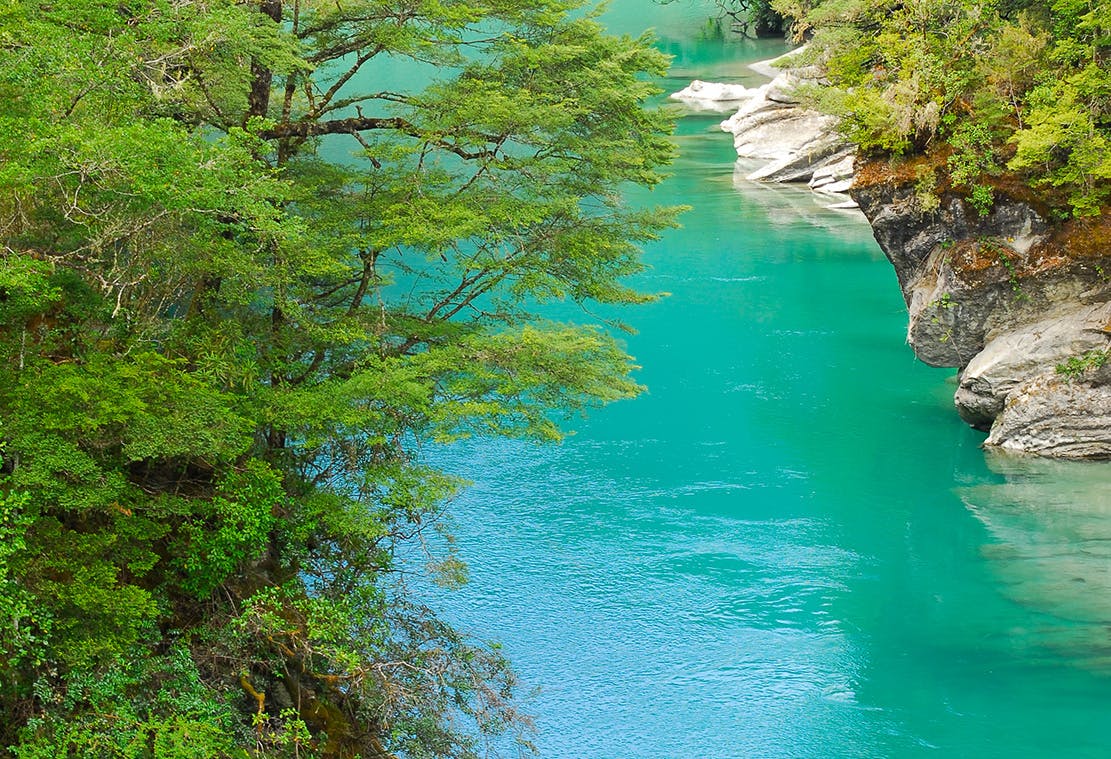
The Matakitaki’s gently flowing waters a novice kayaker’s dream. Photo: Zak Shaw Photography
Flowing from the Southern Alps in Nelson Lakes National Park north of Lewis Pass, the Matakitaki flows north and west for 65km and joins the Buller River at Murchison. In 2008, Network Tasman conducted a pre-feasibility study into the possibility of constructing up to three dams on the Matakitaki River, including one which would inundate the middle of the river and reduce the flow in the lower reaches.
Network Tasman has shelved the proposal due to unfavourable economic conditions, but that doesn’t mean the river is safe.
Mick Hopkinson instructs on the river and says the Matakitaki is “every beginner kayaker’s dream”. He says there are 1250 descents on the middle Matakitaki every year and about another 1000 on the lower reaches. This, he says, means bed nights for the township.
While he’s pleased the project has been shelved, Hopkinson doesn’t trust it will stay that way. “One minute they’re proposing to dam it, the next it’s shelved so you never really know what might happen,” he says. “What happens if the economy picks up?”
5. Tukituki River, Hawke’s Bay
Threat: Irrigation and pollution
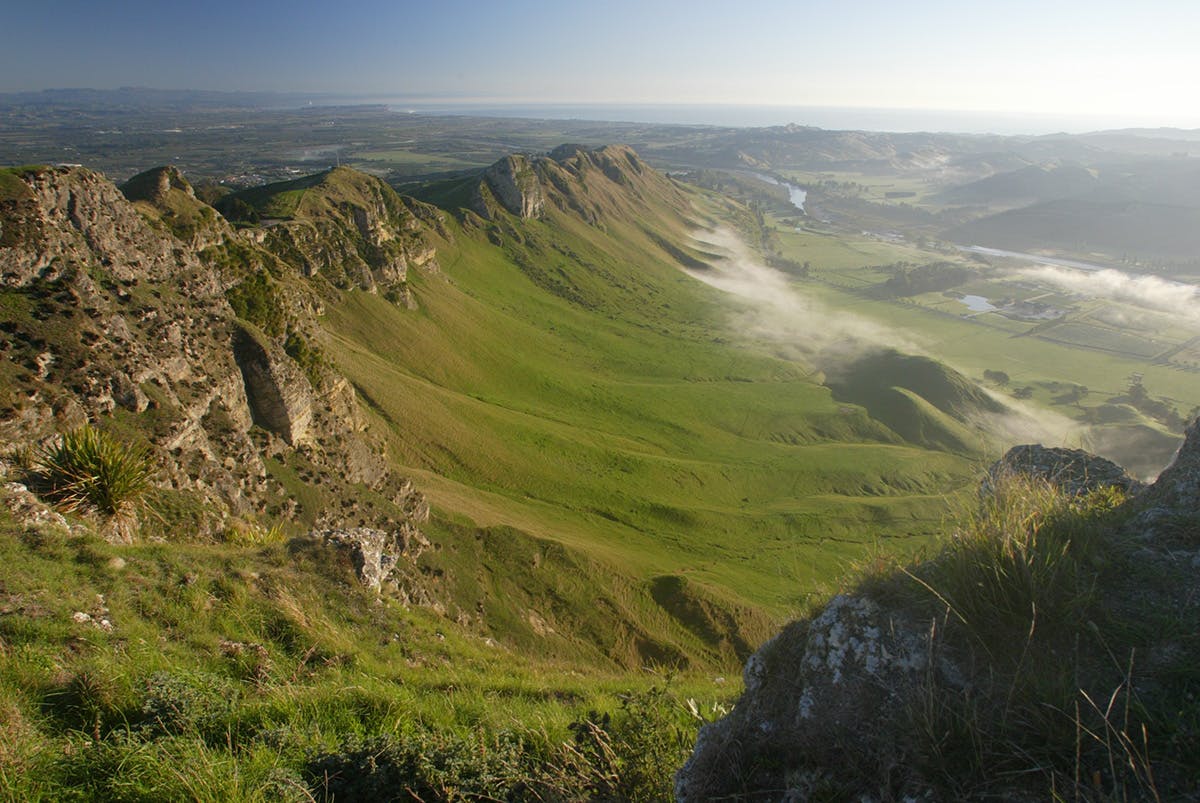
The Tukituki is under threat from irrigation and pollution from dairy intensification. Photo: Hawke’s Bay District Council
Hawke’s Bay fishing guide Dave Hern is worried about the Tukituki River. During the summer months he says the river has no surface flow. “It’s not just because of water extraction for irrigation,” Hern says. “On a day like this a 25-year-old willow will drink more than 1000 litres of water a day and just between State Highway 2 and State Highway 50 we’ve got more than 140,000 of them on the Tukituki catchment.”
The river’s low flow is why he supports a proposal from Hawke’s Bay Regional Council (HBRC) to construct a water storage dam in a steep gorge on the Makaroro River to capture water over the wetter months for irrigation over the dryer months. Currently water for irrigation is being taken from local river-ways, including the Tukituki, and from a deep aquifer on the Ruataniwha Plains which Hern says at current extraction rates will be drained within 15 years.
If the dam is built it will take pressure off the aquifer, improve the flow of the Tukituki and also create a lake for recreation. But Forest and Bird and some local fishers are opposed to the project because they believe it will result in dairy intensification which will further pollute the Tukituki and Waipawa Rivers. The HBRC admits as much, saying the project would allow an extra 25,000ha to be irrigated.





